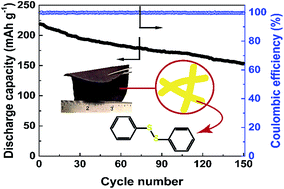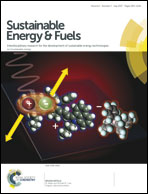A phenyl disulfide@CNT composite cathode for rechargeable lithium batteries†
Abstract
Rechargeable lithium batteries are playing an important role in portable electronics, electric vehicles, and renewable energy storage. Cathode materials in lithium batteries are mainly inorganic; however, some organic materials are also promising for these applications due to their diversified properties. Organosulfides are a unique class of materials which are low cost, abundant, and could provide high capacities. In this work, a phase extraction technique is used to prepare a core–sheath structured composite consisting of carbon nanotubes (CNTs) coated with a layer of phenyl disulfide (PDS, C6H5SSC6H5), which is designated as PDS@CNT. It forms a free-standing and binder-free paper which can be made in a scalable way with high mass loading. In lithium batteries, the S–S bonds in the composite can reversibly break and form in the CNT matrix, enabling good cycling performance. The half-cell can maintain a stable open circuit voltage over a week and deliver a specific capacity of 218 mA h g−1 at 1C while retaining 70% of the initial capacity after 150 cycles.



 Please wait while we load your content...
Please wait while we load your content...